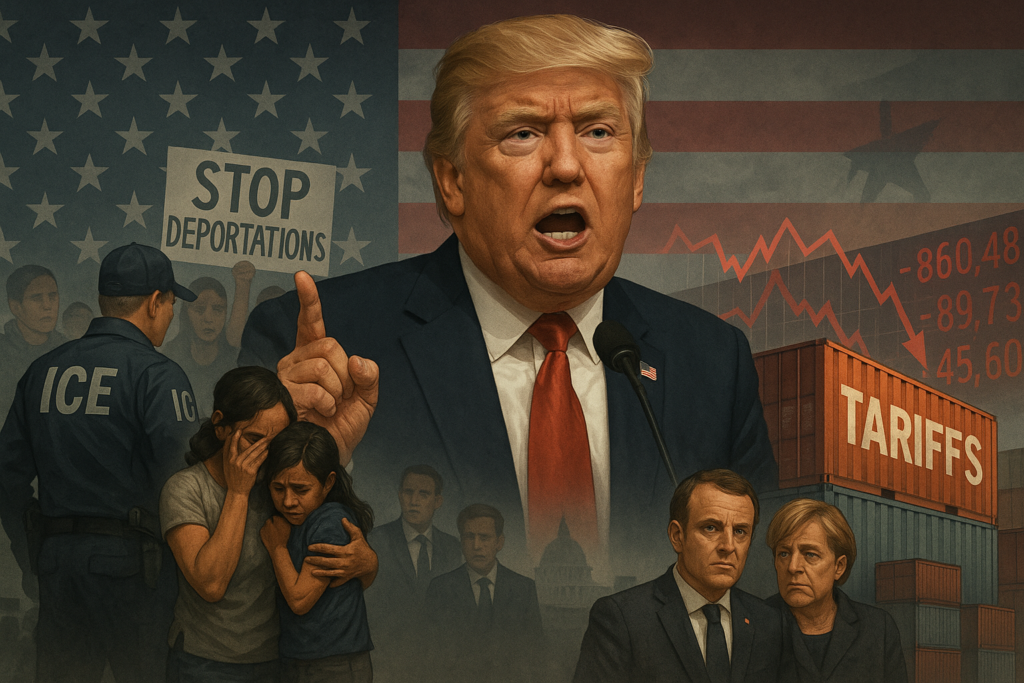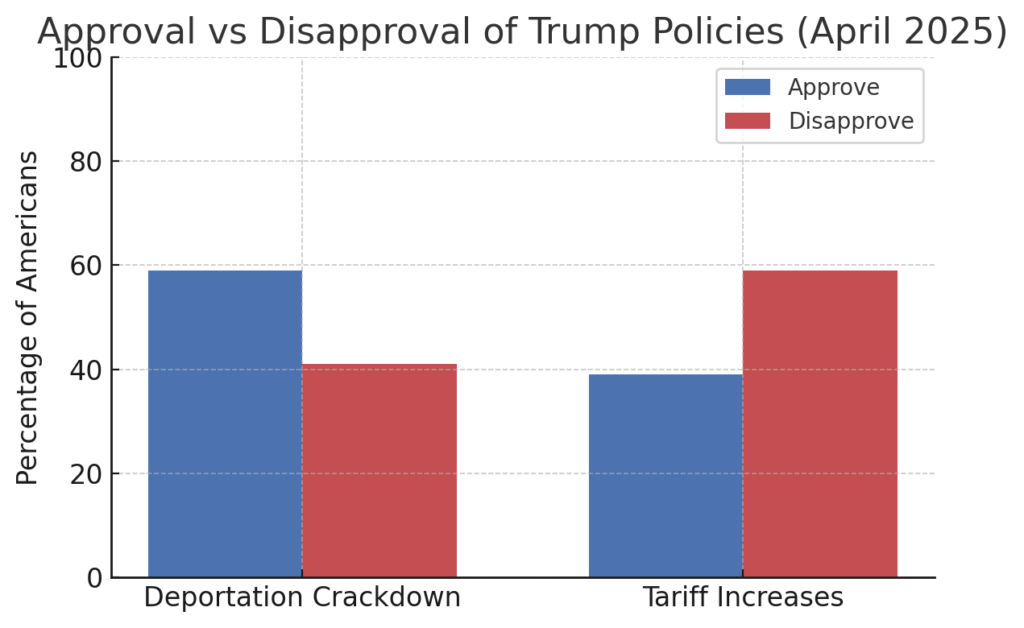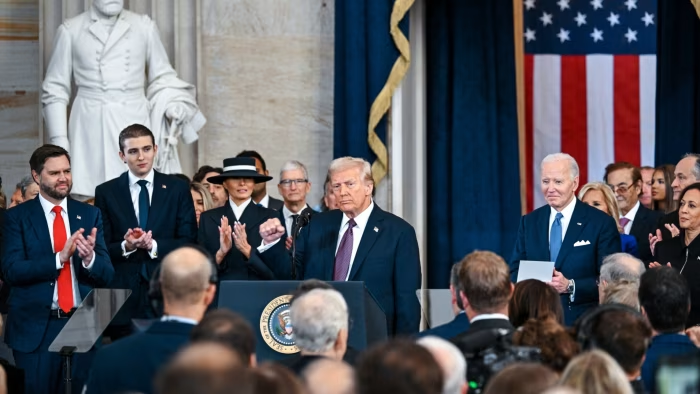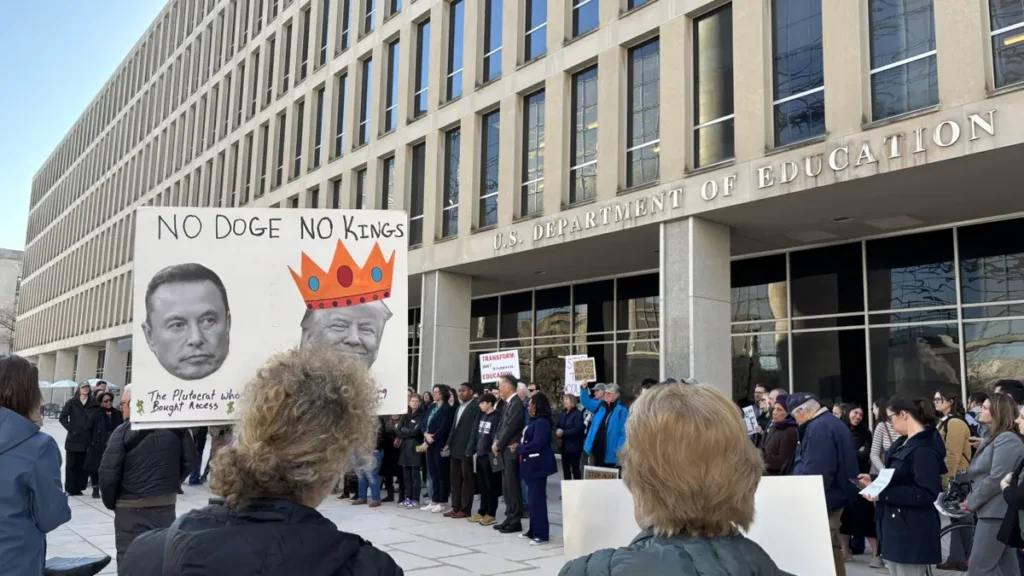

Prefer to listen instead?
Dive into how Trump’s 2025 deportation crackdown and sweeping tariffs are reshaping America’s global image and why Democrats still struggle to offer a clear alternative. Powered by Pixlehale.
Mass Deportation Efforts and Controversies
Upon taking office in January 2025, President Donald Trump moved swiftly to fulfill his campaign pledge of cracking down on illegal immigration. His administration launched what it touted as the “largest domestic deportation operation” in U.S. history. Immigration and Customs Enforcement (ICE) dramatically expanded enforcement: the monthly number of ICE arrests has more than doubled compared to the previous year. The White House also tripled agreements with local police to have them assist in immigration enforcement, an approach critics say risks racial profiling. By the end of April, over 350 deportation flights had departed the U.S. since Trump’s inauguration, including a dozen military-operated flights to countries such as Guatemala, Honduras, Ecuador, and even India. ICE removed approximately 37,660 people in Trump’s first month, which is less than the ~57,000 per month average during President Biden’s last year. Administration officials insist deportation numbers will rise as new initiatives – like deals with Guatemala, El Salvador, Panama and Costa Rica to accept third-country deportees – ramp up.
A centerpiece of the crackdown was Trump’s use of the 1798 Alien Enemies Act, a wartime-era law, to fast-track removals. In a high-profile operation on March 15, U.S. agents rounded up over 250 alleged gang members – mostly Venezuelans – and deported them to El Salvador to be imprisoned in a mega-facility. This occurred despite a federal judge’s order to halt the flights, as the administration argued the court had no authority to stop a plane already in the air. Salvadoran President Nayib Bukele confirmed receiving 238 members of Venezuela’s Tren de Aragua gang and 23 MS-13 members under a deal in which the U.S. will pay El Salvador to detain them in a 40,000-capacity “terrorism confinement center.” Legal experts note that invoking the Alien Enemies Act in peacetime is unprecedented, and immigrant advocates warn that basic due process is being sidestepped. The administration has shown a willingness to defy judicial checks – prompting what one outlet called a constitutional “clash with the judicial branch.”
Trump’s hardline approach has ensnared not only undocumented immigrants but also some with legal status – and even U.S. citizens. In late April, a judge in Louisiana revealed that ICE deported a 2-year-old American citizen to Honduras, along with her non-citizen mother, “with no meaningful process” to verify the child’s rights. In a separate Florida case, the mother of a 1-year-old U.S. citizen was deported, leaving her infant behind and effectively separating the family indefinitely. Critics say the administration’s rush to deport has frequently avoided due process and ignored humanitarian considerations. Trump officials defend their tactics, claiming parents often elect to take U.S.-born children with them and that the focus remains on criminals and security threats. Nonetheless, such stories of citizens and legal residents caught in the dragnet have raised alarm and undercut the administration’s narrative that enforcement is only targeting “foreign criminals.”
Sweeping Tariffs and Trade Wars
In parallel with the immigration crackdown, Trump unleashed a bold economic nationalist agenda, centered on sweeping import tariffs. Within weeks of taking office, he resurrected and escalated the trade wars of his first term. On February 1, Trump declared a national emergency over trade imbalances and announced new tariffs: 10% on all Chinese imports and a steep 25% tariff on most goods from Mexico and Canada. He justified these as measures to combat illegal immigration and drug trafficking from those countries. The announcement sparked immediate outrage from U.S. neighbors and trading partners, prompting threats of retaliation. Within days, the White House partly walked back the plan, granting a 30-day pause on the Mexico/Canada tariffs after those governments offered concessions on border security. However, the 10% tariff on China took effect on Feb. 4, to which Beijing retaliated with its own duties on U.S. products and even an antitrust probe into Google.
Trump’s protectionist push only accelerated from there. In March, he removed exemptions on steel and aluminum, slapping a blanket 25% duty on all steel and raising aluminum tariffs from 10% to 25%. He also signaled tariffs on lumber and autos: by March 26, Trump proclaimed a 25% tariff on all automobile imports, aiming to boost domestic manufacturing. Canada’s government responded by matching Trump’s auto tariffs with a 25% tax on U.S. vehicle imports that don’t meet USMCA trade rules. China escalated countermeasures: it hiked tariffs on key American farm goods by 15% and later announced a sweeping 34% tariff on all U.S. products starting April 10. Beijing further restricted exports of rare earth minerals vital to tech industries.
The showdown culminated in early April. On April 2 – dubbed “Liberation Day” by President Trump – he unveiled “reciprocal tariffs” designed to force trading partners into balance. This policy imposed a minimum 10% tariff on every import into the U.S. and even higher rates (ranging from 11% up to 50%) on dozens of countries with large trade surpluses with America. Previously implemented 25% tariffs on steel, aluminum, and autos were kept in place or expanded. The administration temporarily exempted Canada and Mexico from the new baseline tariff – as long as their exports complied with USMCA trade rules – while hitting their non-compliant goods with the full 25% tariff.
Global markets recoiled. Investors reacted to the April 2 announcement with deep alarm, and the next day U.S. stock indices plunged in what was described as the worst single-day drop in years. International finance officials warned of a potential 2025 stock market crash attributable to the tariff shock. Facing market turmoil and pushback from business leaders, the Trump administration partially walked back the tariffs – at least temporarily. On April 9, just hours after higher tariff rates took effect, the White House suspended most of the additional country-specific hikes for 90 days (the 10% blanket tariff remained in force). China was the sole exception: having already been hit with U.S. tariffs totaling 104%, Beijing’s retaliation and Washington’s counter-retaliation pushed the duties to extraordinary levels – 145% on Chinese imports into the U.S., and roughly 84% on U.S. goods into China.
Economic analysts say Trump’s tariff gambit is gambling with recession. Between January and April, the average effective U.S. tariff rate skyrocketed from about 2.5% to an estimated 27% – the highest level in over a century. The Federal Reserve and OECD have downgraded U.S. growth projections, citing the tariff disruptions. In April, the International Monetary Fund cut its U.S. 2025 GDP forecast by nearly 1 percentage point and warned that “extremely high” trade tensions are dragging down economies worldwide. Inflation is expected to tick upward due to pricier imports, and American exporters are feeling the pain from foreign retaliation. While the administration insists tariffs will incentivize companies to bring manufacturing back home, in the short term these policies have injected volatility and uncertainty into the economy.
Impact on U.S. Global Image
Trump’s aggressive moves on deportations and trade have had significant fallout for America’s global image. Longstanding allies and international organizations have openly criticized the new administration’s approach as heavy-handed and destabilizing. On immigration, human rights groups argue that the U.S. is abandoning its traditional role as a safe haven and flouting basic humanitarian norms. The use of third-country deportation agreements – essentially outsourcing U.S. asylum seekers to other nations – is particularly controversial.
In one little-noticed February operation, the U.S. quietly deported about 200 asylum seekers from Asia, Africa, and the Middle East to Costa Rica and another 300 to Panama instead of allowing them to file claims in the U.S. Many were children or had fled persecution in countries like China, Iran, and Ethiopia. Upon arrival, these migrants were held in makeshift facilities; some hung protest signs from windows pleading for help. Legal challenges eventually forced the release of many migrants, but they remain in limbo. Such tactics have prompted international outcry and reports labeling this a humanitarian crisis.
Allies in the Western Hemisphere have pushed back. In late January, Colombia’s president initially refused entry to two U.S. military planes carrying deported migrants, accusing Washington of treating people inhumanely. Mexico has also raised concerns, especially after the U.S. declared parts of the border region a restricted defense zone, allowing arrests of migrants on federal trespassing charges. Reports that the U.S. may send asylum seekers to countries like Libya or Rwanda have added to the controversy.
On trade, the European Union condemned Trump’s tariff blitz, with EU officials warning that the U.S. is weaponizing global trade. They prepared retaliatory tariffs on billions in U.S. goods. In Asia, China’s state media has criticized the U.S. for economic aggression, and Japan’s stock market suffered heavy losses in response to U.S. tariff announcements. Across the board, the sentiment is clear: America is seen as an increasingly unpredictable and aggressive partner.
Domestic Public Opinion
At home, Trump’s policies have drawn sharp divisions. A majority of Americans support tougher immigration enforcement. Surveys show around 59% approve of increased deportations of undocumented immigrants, though support declines when stories surface about legal residents or citizens being deported.

On the other hand, public opinion on tariffs is less favorable. A majority disapprove of the sweeping tariff hikes, expressing concerns about inflation, job losses, and market volatility. Only around 39% support the current approach. Trump’s overall approval has dropped, with his job approval hovering around 40% as of early May. Still, his support remains solid among Republican voters.
Political Reactions: Republicans vs. Democrats
Republicans have mostly aligned with Trump. On immigration, they argue he is fulfilling campaign promises and restoring law and order. On tariffs, many support the notion of reciprocal trade, although some business-aligned Republicans have expressed concern about long-term economic damage.
Democrats, meanwhile, have condemned the administration’s policies but face criticism for lacking a cohesive alternative. While they highlight the humanitarian toll and economic risks, the party continues to debate internally how to win back working-class voters. Polls suggest Democrats’ favorability remains low, and voters are not yet convinced they offer a better solution.
Outlook
As of May 2025, the United States finds itself at a political and diplomatic crossroads. Trump’s administration has aggressively reshaped immigration and trade policy, sparking backlash abroad and division at home. While many disapprove of his actions, Democrats have yet to rally a strong counter-narrative. If a snap election were held today, the outcome would remain uncertain. What’s clear is that both parties face immense pressure to define their vision for the country amid escalating tensions and public discontent.


